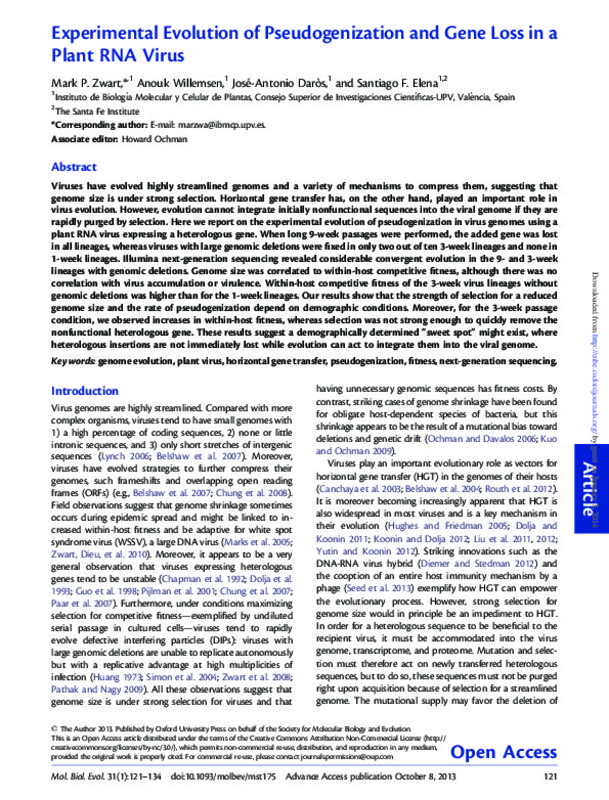Zwart, MP.; Willemsen, A.; Daros Arnau, JA.; Elena Fito, SF. (2014). Experimental evolution of pseudogenization and gene loss in a plant RNA virus. Molecular Biology and Evolution. 31(1):121-134. https://doi.org/10.1093/molbev/mst175
Por favor, use este identificador para citar o enlazar este ítem: http://hdl.handle.net/10251/72658
|
Título:
|
Experimental evolution of pseudogenization and gene loss in a plant RNA virus
|
|
Autor:
|
Zwart, Mark Peter
Willemsen, Anouk

 Daros Arnau, Jose Antonio
Elena Fito, Santiago Fco
Daros Arnau, Jose Antonio
Elena Fito, Santiago Fco
|
|
Entidad UPV:
|
Universitat Politècnica de València. Instituto Universitario Mixto de Biología Molecular y Celular de Plantas - Institut Universitari Mixt de Biologia Molecular i Cel·lular de Plantes
|
|
Fecha difusión:
|
|
|
Resumen:
|
[EN] Viruses have evolved highly streamlined genomes and a variety of mechanisms to compress them, suggesting that genome size is under strong selection. Horizontal gene transfer has, on the other hand, played an important ...[+]
[EN] Viruses have evolved highly streamlined genomes and a variety of mechanisms to compress them, suggesting that genome size is under strong selection. Horizontal gene transfer has, on the other hand, played an important role in virus evolution. However, evolution cannot integrate initially nonfunctional sequences into the viral genome if they are rapidly purged by selection. Here we report on the experimental evolution of pseudogenization in virus genomes using a plant RNA virus expressing a heterologous gene. When long 9-week passages were performed, the added gene was lost in all lineages, whereas viruses with large genomic deletions were fixed in only two out of ten 3-week lineages and none in 1-week lineages. Illumina next-generation sequencing revealed considerable convergent evolution in the 9- and 3-week lineages with genomic deletions. Genome size was correlated to within-host competitive fitness, although there was no correlation with virus accumulation or virulence. Within-host competitive fitness of the 3-week virus lineages without genomic deletions was higher than for the 1-week lineages. Our results show that the strength of selection for a reduced genome size and the rate of pseudogenization depend on demographic conditions. Moreover, for the 3-week passage condition, we observed increases in within-host fitness, whereas selection was not strong enough to quickly remove the nonfunctional heterologous gene. These results suggest a demographically determined "sweet spot" might exist, where heterologous insertions are not immediately lost while evolution can act to integrate them into the viral genome.
[-]
|
|
Palabras clave:
|
Genome evolution
,
Plant virus
,
Horizontal gene transfer
,
Pseudogenization
,
Fitness
,
Next-generation sequencing
|
|
Derechos de uso:
|
Reconocimiento - No comercial (by-nc)
|
|
Fuente:
|
Molecular Biology and Evolution. (issn:
0737-4038
) (eissn:
1537-1719
)
|
|
DOI:
|
10.1093/molbev/mst175
|
|
Editorial:
|
Oxford University Press (OUP): Molecular Biology and Evolution
|
|
Versión del editor:
|
https://dx.doi.org/10.1093/molbev/mst175
|
|
Código del Proyecto:
|
info:eu-repo/grantAgreement/JTF//22371/
info:eu-repo/grantAgreement/MINECO//BFU2012-30805/ES/EVOLUTIONARY SYSTEMS VIROLOGY: EPISTASIS AND THE RUGGEDNESS OF ADAPTIVE LANDSCAPES, MUTATIONS IN REGULATORY SEQUENCES, AND THE HOST DETERMINANTS OF VIRAL FITNESS/
info:eu-repo/grantAgreement/MICINN//JCI-2011-10379/ES/JCI-2011-10379/
info:eu-repo/grantAgreement/MICINN//BIO2011-26741/ES/PATOGENOS DE RNA DE PLANTAS: INTERACCION CON EL HUESPED Y DESARROLLO DE HERRAMIENTAS BIOTECNOLOGICAS/
|
|
Agradecimientos:
|
The authors thank Alejandro Manzano Marin for his bioinformatics guidance with the Illumina analysis and Francisca de la Iglesia, Paula Agudo, and Angels Prosper for technical support. This project was made possible through ...[+]
The authors thank Alejandro Manzano Marin for his bioinformatics guidance with the Illumina analysis and Francisca de la Iglesia, Paula Agudo, and Angels Prosper for technical support. This project was made possible through the support of grant 22371 from the John Templeton Foundation to S. F. E. The opinions expressed in this publication are those of the authors and do not necessarily reflect the views of John Templeton Foundation. Additional support was received from the Spanish Direccion General de Investigacion Cientifica y Tecnica grants BFU2012-30805 to S. F. E, JCI2011-10379 to M.P.Z, and BIO2011-26741 to J.A.D., and by a Rubicon grant from the Netherlands Organization for Scientific Research (www.nwo.nl) to M.P.Z.
[-]
|
|
Tipo:
|
Artículo
|









